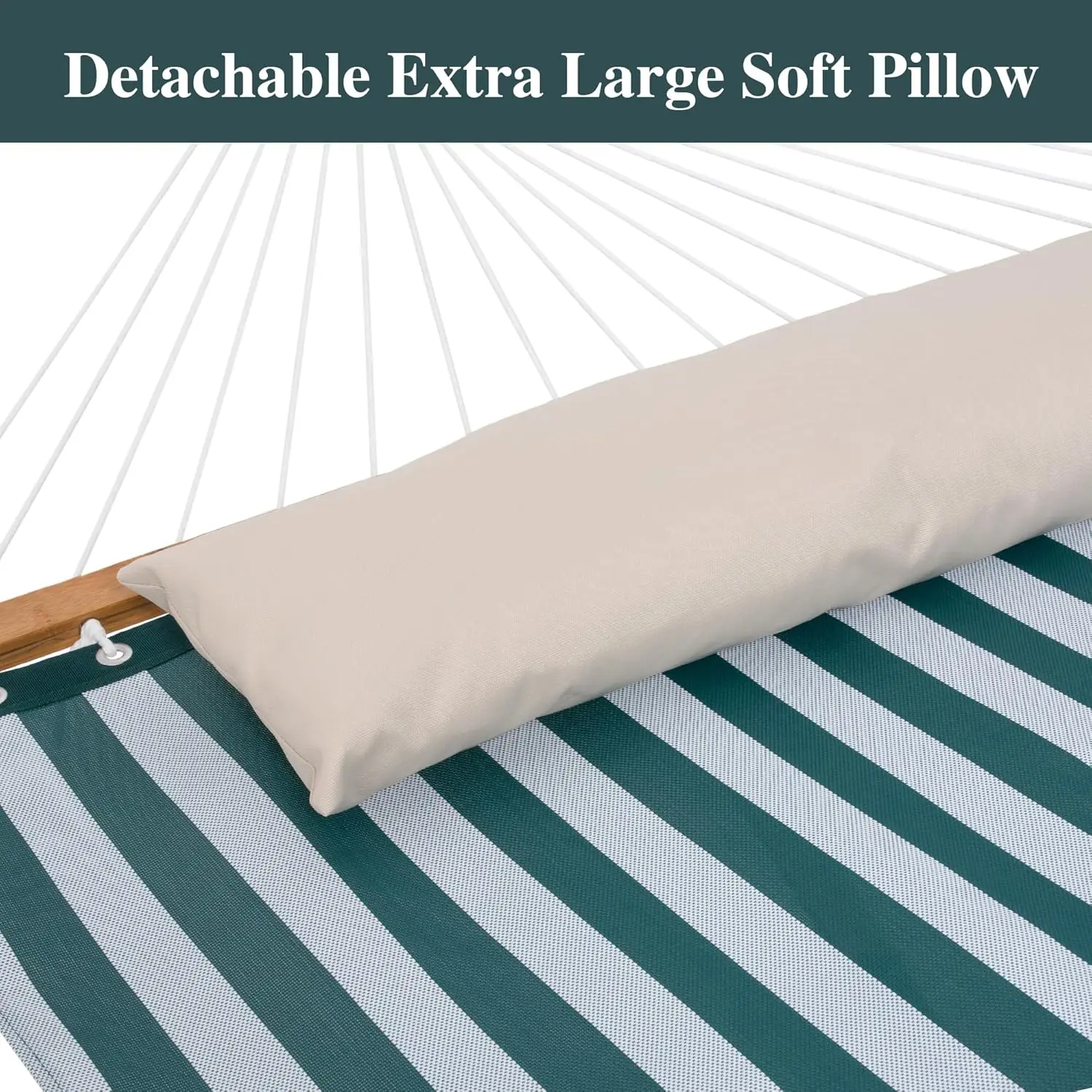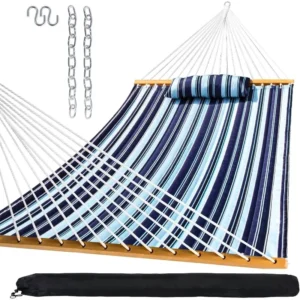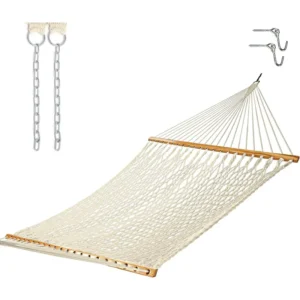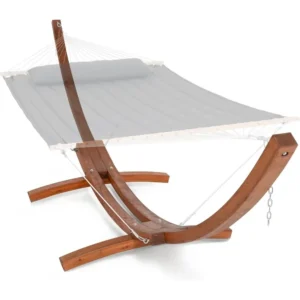Understanding Hammock Depth: The Science Behind Perfect Lounging
When it comes to hammock comfort, depth is everything. But what exactly is hammock “depth” or “sag”? Simply put, it’s the curved shape that forms when your hammock is properly hung between two points. This curve isn’t just visually appealing—it’s scientifically designed to cradle your body in perfect comfort.
Proper hammock depth is crucial because it directly affects how weight distributes across the fabric. A well-hung hammock with optimal depth spreads your body weight evenly, eliminating uncomfortable pressure points that can cause pain in your back, shoulders, and hips. The right curve works with your body rather than against it.
Many hammock newcomers make a common mistake: thinking a flat hammock is more comfortable. In reality, a properly sagged hammock creates a more ergonomic lounging experience by:
- Distributing weight evenly across a larger surface area
- Supporting the natural curve of your spine
- Preventing the “taco effect” where edges squeeze your shoulders
- Reducing strain on anchor points and suspension
The physics behind hammock depth is fascinating—a proper curve follows what hammock enthusiasts call a “smile curve” rather than a “banana curve.” The smile curve allows for diagonal positioning and creates a near-flat lay despite the curved appearance when empty. Understanding the core concept of hammock depth for comfort helps you avoid the common pitfalls of improper setup.
With the right depth, your hammock transforms from a simple suspended piece of fabric into an ergonomic lounging masterpiece. Many deep-seat chair hammock sets are specifically designed with this optimal depth in mind, making setup easier and comfort more accessible.
The Golden Rule: Finding the Optimal 30-Degree Hang Angle
The secret to perfect hammock depth lies in one simple number: 30 degrees. This refers to the angle between your suspension (the straps or ropes connecting to trees or stands) and an imaginary horizontal line. While it might sound technical, this specific angle creates the ideal sag for most gathered-end hammocks.
Why is 30 degrees so magical? At this precise angle, several critical things happen:
- The hammock fabric forms an optimal curve for body support
- Tension on suspension components reduces by approximately 50% compared to horizontal suspension
- The hammock neither hangs too flat (causing instability) nor too deeply (causing excessive wrapping)
- The fabric maintains its structural integrity and longevity
Don’t worry—you don’t need special equipment to measure this angle. A simple “finger gun” method works remarkably well: extend your arm toward your anchor point with thumb up and index finger pointing forward. If your thumb aligns with your suspension and your finger points horizontally, you’re close to that perfect 30-degree angle.
This golden angle applies universally regardless of the distance between anchor points or your weight. The ultimate guide to deep-seat hammocks explains how this angle creates the foundation for comfort by establishing the proper depth before you even get in.
The 30-degree rule is the critical first step in achieving that perfect hammock depth. Once mastered, you’ll immediately notice improved comfort and reduced strain on your body during lounging sessions.
Achieving Perfect Hammock Depth: Step-by-Step Guide
Let’s translate theory into practice with a comprehensive approach to hanging your hammock at the perfect depth:
Select appropriate anchor points that are sturdy enough to support your weight and positioned 2-3 feet (0.6-0.9 meters) farther apart than your hammock’s total length. This extra distance allows for proper sag.
Attach your suspension system at approximately waist to chest height (typically 4-5 feet or 1.2-1.5 meters from the ground).
Adjust suspension height so the bottom of your empty hammock sits about 18 inches (45 cm) from the ground—roughly chair seat height.
Check your suspension angle using the finger-gun method described earlier, aiming for that critical 30-degree angle.
Test and fine-tune by sitting gently in the middle and adjusting height as needed. Your seated position should leave you about 12-16 inches (30-40 cm) from the ground.
Make weight-specific adjustments as needed. Heavier individuals may need to start with slightly higher anchor points as the hammock will stretch more under weight.
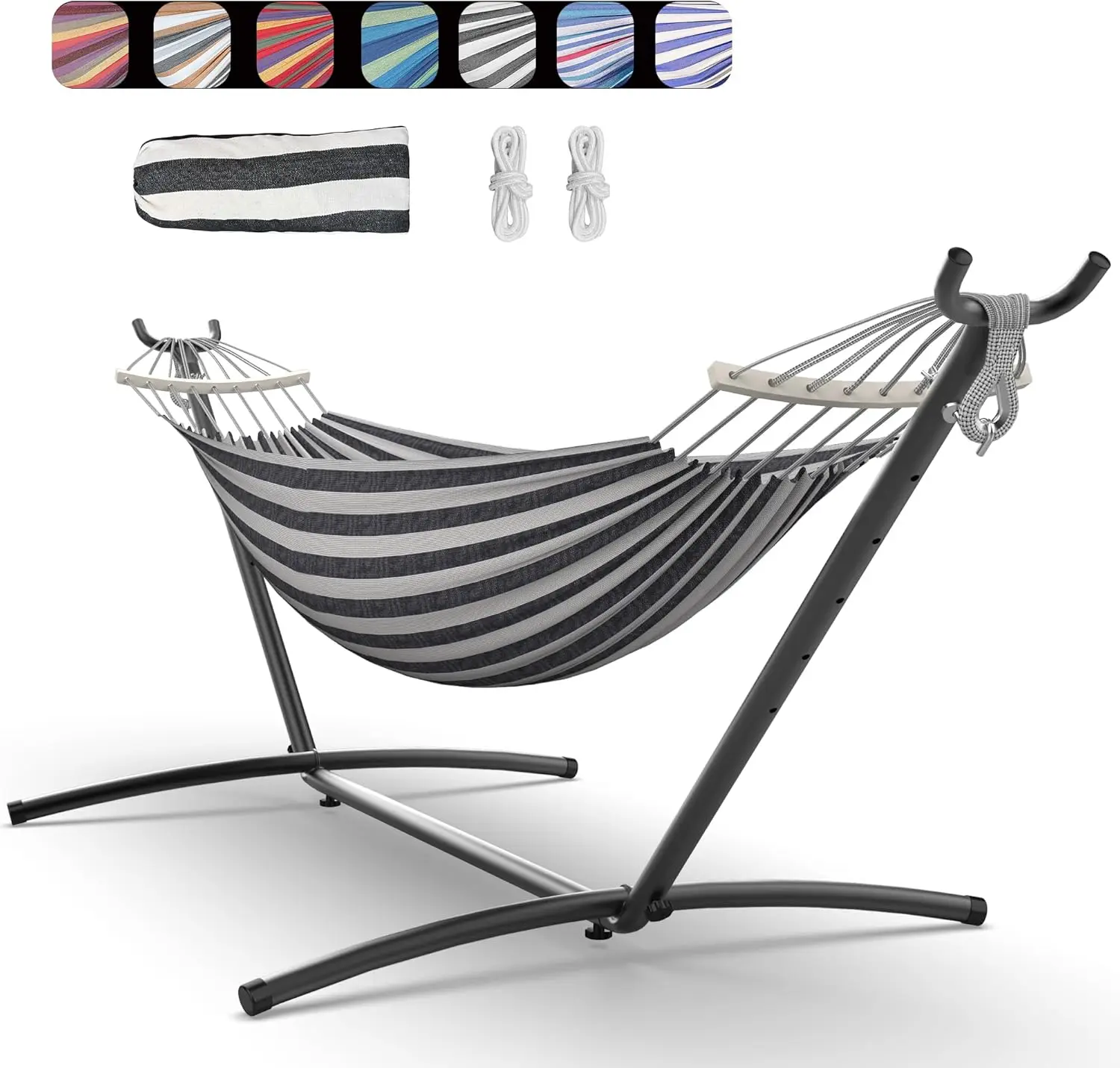
The perfect depth creates a gentle curve where your body can lie diagonally across the fabric. This approach helps you avoid common issues like feeling unstable, experiencing shoulder squeeze, or dealing with uncomfortable fabric tension across your back. Understanding the differences between deep hammocks vs standard hammocks can help you choose the right option for your comfort needs.
Remember that achieving ideal depth often requires minor adjustments based on your body type, weight, and personal preference. Many complete hammock systems with stands are designed to make achieving this perfect depth straightforward, with preset heights and adjustable features that take the guesswork out of setup.
The Ridgeline Secret: Maintaining Consistent Perfect Depth
For hammock enthusiasts seeking perfect consistency in their lounging experience, a structural ridgeline is the ultimate solution. This simple yet ingenious addition is a cord that runs from one end of your hammock to the other, above where you lie.
The ridgeline serves one critical purpose: controlling hammock sag regardless of hang distance or suspension adjustments. It effectively locks in your perfect depth every time you hang your hammock.
The magic number for ridgeline length is approximately 83% of your hammock’s total length. For example:
– 10-foot (3-meter) hammock × 0.83 = 8.3-foot (2.5-meter) ridgeline
– 11-foot (3.35-meter) hammock × 0.83 = 9.13-foot (2.78-meter) ridgeline
This specific proportion creates the optimal depth for most users while allowing enough slack for comfortable diagonal positioning. When selecting ridgeline material, consider:
- Amsteel or Dyneema for superior strength-to-weight ratio and minimal stretch
- Paracord for a budget-friendly option (though it stretches more over time)
- Weight capacity needs (premium lines can support 500+ pounds or 225+ kg)
Beyond maintaining consistent depth, a ridgeline offers additional benefits like providing a convenient place to hang small items or attach a bug net. Mastering deep-seat hammock relaxation becomes much easier with a properly configured ridgeline that eliminates the need for constant readjustment.
The ridgeline approach is particularly valuable for those who frequently move their hammock between different locations, as it ensures your comfortable depth remains consistent regardless of the distance between trees or anchor points.
Mastering the Diagonal Lay: The Key to Flat Comfort at Perfect Depth
The secret technique that transforms a curved hammock into a flat, comfortable lounging surface is the diagonal lay. This approach involves positioning your body at an angle of approximately 30-45 degrees off the centerline of the hammock.
When combined with proper hammock depth, the diagonal lay creates magic:
- Your body weight spreads across more fabric, reducing pressure points
- Your spine aligns naturally without uncomfortable curves
- The hammock effectively widens by up to 30% through diagonal positioning
- Your head and feet can lie nearly flat rather than being elevated
To master the diagonal lay:
- Enter the hammock and sit in the center as you normally would
- Rotate your body so your head moves toward one side and your feet toward the opposite side
- Extend your legs along the diagonal line of the hammock
- Allow your shoulders to sink comfortably into the fabric
Different hammock widths require slightly different diagonal angles. Wider hammocks allow for a more pronounced diagonal position, while narrower ones might limit how far off-center you can comfortably lie.
Hammocks with appropriate fabric that offers some stretch can enhance the diagonal lay experience by conforming to your body shape while maintaining structural support. The diagonal lay works for both lounging and sleeping, though sleeping may require a slightly more pronounced diagonal position to ensure flat alignment of your spine.
The combination of proper depth and diagonal positioning is what separates casual hammock users from those who experience truly transformative comfort. This technique is why hammock enthusiasts insist that a properly hung hammock is more comfortable than many beds!
Depth & Comfort: Solutions to Common Hammock Problems
Even with the best intentions, hammock setup issues can lead to discomfort. Here’s how to diagnose and solve common problems directly related to incorrect hammock depth:
Problem: Shoulder Squeeze/Cocoon Effect
* Cause: Hammock hung too tightly with insufficient sag
* Solution: Loosen suspension to increase depth and achieve proper 30-degree angle
Problem: Calf Pressure/Ridge Under Legs
* Cause: Insufficient depth causing fabric tension across backs of legs
* Solution: Increase hammock sag and ensure proper diagonal positioning
Problem: Hyperextended Knees
* Cause: Excessive depth causing your body to fold too much at the center
* Solution: Reduce hammock sag slightly by tightening suspension
Problem: Unstable Rocking Sensation
* Cause: Hammock hung with uneven tension or improper depth
* Solution: Ensure even 30-degree angles on both sides and consistent height
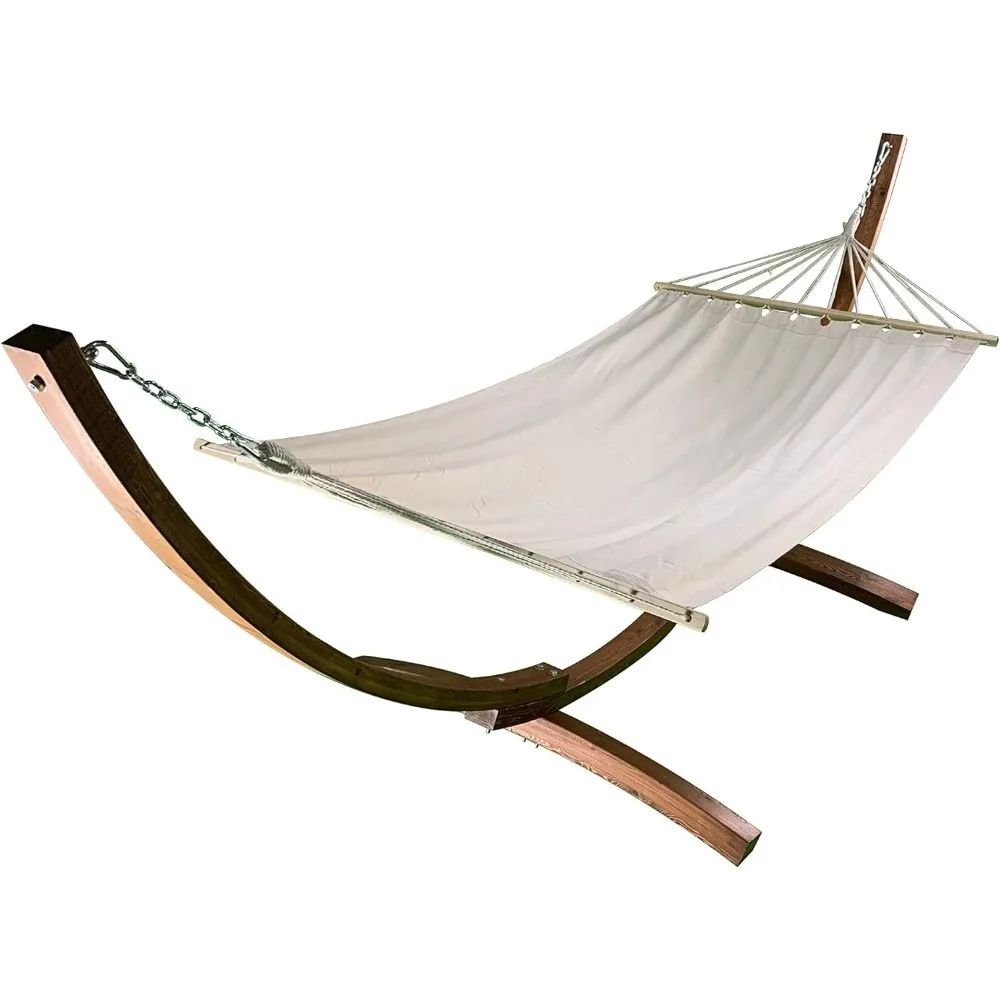
When troubleshooting, start with small adjustments—sometimes just an inch or two of height difference can transform comfort. Remember that spine-friendly hammock relaxation depends on finding that sweet spot between too tight and too loose.
Quick troubleshooting tip: If you’re experiencing discomfort in your upper body (shoulders, neck, back), the issue is usually too little sag. If discomfort occurs in your lower body (knees, calves, feet), the problem is often too much sag.
With practice and attention to these common issues, you’ll develop an intuitive sense for perfect hammock depth that works for your unique body type and comfort preferences.
How Hammock Type Affects Ideal Depth
Different hammock designs require different approaches to depth for optimal comfort:
Gathered-End Hammocks
These traditional hammocks gather fabric at each end into a bundle. They require significant depth, and the 30-degree rule applies perfectly. Their deep curve enables the diagonal lay that creates flat comfort. These versatile hammocks offer the most customizable depth experience.
Bridge Hammocks
Bridge designs use spreader bars at the head and foot while maintaining fabric walls on the sides. They require moderate sag (typically 20-25 degrees) and follow manufacturer specifications more strictly. The built-in structure means depth adjustments have less dramatic effects on comfort than with gathered-end styles.
Spreader Bar Hammocks
These familiar backyard hammocks have wooden or metal bars that spread the fabric at both ends. They function best with minimal sag (10-15 degrees) as too much depth creates instability. Their design prioritizes visual appeal and ease of entry over ergonomic sleeping comfort.
Hammocks with spreader bars offer a flatter surface by design but sacrifice some of the ergonomic benefits of deeper-hanging options. They’re excellent for casual lounging but may create pressure points during extended use compared to properly hung gathered-end hammocks.
Material differences also affect depth considerations:
– Cotton hammocks stretch significantly more under weight
– Nylon provides moderate stretch and excellent weight support
– Polyester offers minimal stretch for more consistent depth
Understanding your specific hammock type helps you apply depth principles appropriately while maximizing the comfort potential of your particular design.
Beyond Depth: Other Factors Affecting Hammock Comfort
While depth creates the foundation for hammock comfort, several other factors work together to enhance your lounging experience:
Hammock Dimensions
– Length: Should exceed your height by at least 2 feet (60 cm) for proper diagonal positioning
– Width: Wider hammocks (5-6 feet/1.5-1.8 meters) provide more fabric for diagonal positioning
– Fabric surface area: More fabric generally means better weight distribution and comfort
Material Characteristics
– Stretch: Determines how the hammock conforms to your body and maintains depth
– Breathability: Affects temperature regulation during extended lounging
– Texture: Influences skin comfort and friction when repositioning
Environmental Considerations
– Location protection from wind, sun, and precipitation
– Temperature management through underquilts or top quilts
– Ground clearance for safety and convenience
Supportive Accessories
– Pillows or stuff sacks positioned for neck support
– Ridgelines for consistent depth and accessory attachment
– Structural modifications like knotty mods or end-caps
Hammocks with enhanced capacity maintain proper depth even when supporting higher weights, making them excellent options for larger individuals or those wanting extra stability.
A-Frame Stand Hammock Sets, Swinging Hammock Chair Sets
$154.62 Select options This product has multiple variants. The options may be chosen on the product pageClassic Wooden Stand Hammock Sets, Heavy Duty Hammock Sets
$1,061.68 Select options This product has multiple variants. The options may be chosen on the product pageHammock Sets with Canopy, Heavy Duty Hammock Sets
$286.31 Select options This product has multiple variants. The options may be chosen on the product pageDouble / Two Person Hammock Sets, Rope Hammock Sets
Double Traditional Cotton Rope Hammock with Extension Chains – 450 lbs Capacity for Backyard & Patio$292.98 Select options This product has multiple variants. The options may be chosen on the product pageHeavy Duty Hammock Sets, Wooden Arc Stand Hammock Sets
$878.66 Select options This product has multiple variants. The options may be chosen on the product page
Remember that optimal depth creates the foundation upon which these other comfort factors build. Even the most premium hammock materials cannot compensate for improper depth, but when combined with perfect depth, they create an unmatched lounging experience.
Is Your Hammock Depth Perfect? A Quick Assessment Checklist
Use this simple checklist to evaluate whether your hammock has achieved optimal depth for maximum comfort:
✓ Visual Indicators
– Empty hammock forms a clear “smile” curve when viewed from the side
– Bottom of empty hammock sits at approximately chair height (18 inches/45 cm)
– Suspension straps form roughly 30-degree angles with the horizontal
– No excessive wrinkles or tight spots visible in the fabric
✓ Comfort Assessment
– Body lies relatively flat when positioned diagonally
– No pressure points on shoulders or calves
– Head and feet are slightly lower than hips when lying down
– No sensation of being folded in half at the center
✓ Technical Verification
– Ridgeline (if present) is taut but not straining the hammock ends
– Gentle rocking motion feels stable, not tippy
– Minimal fabric stretch after entering the hammock
– Even tension across the entire hammock surface
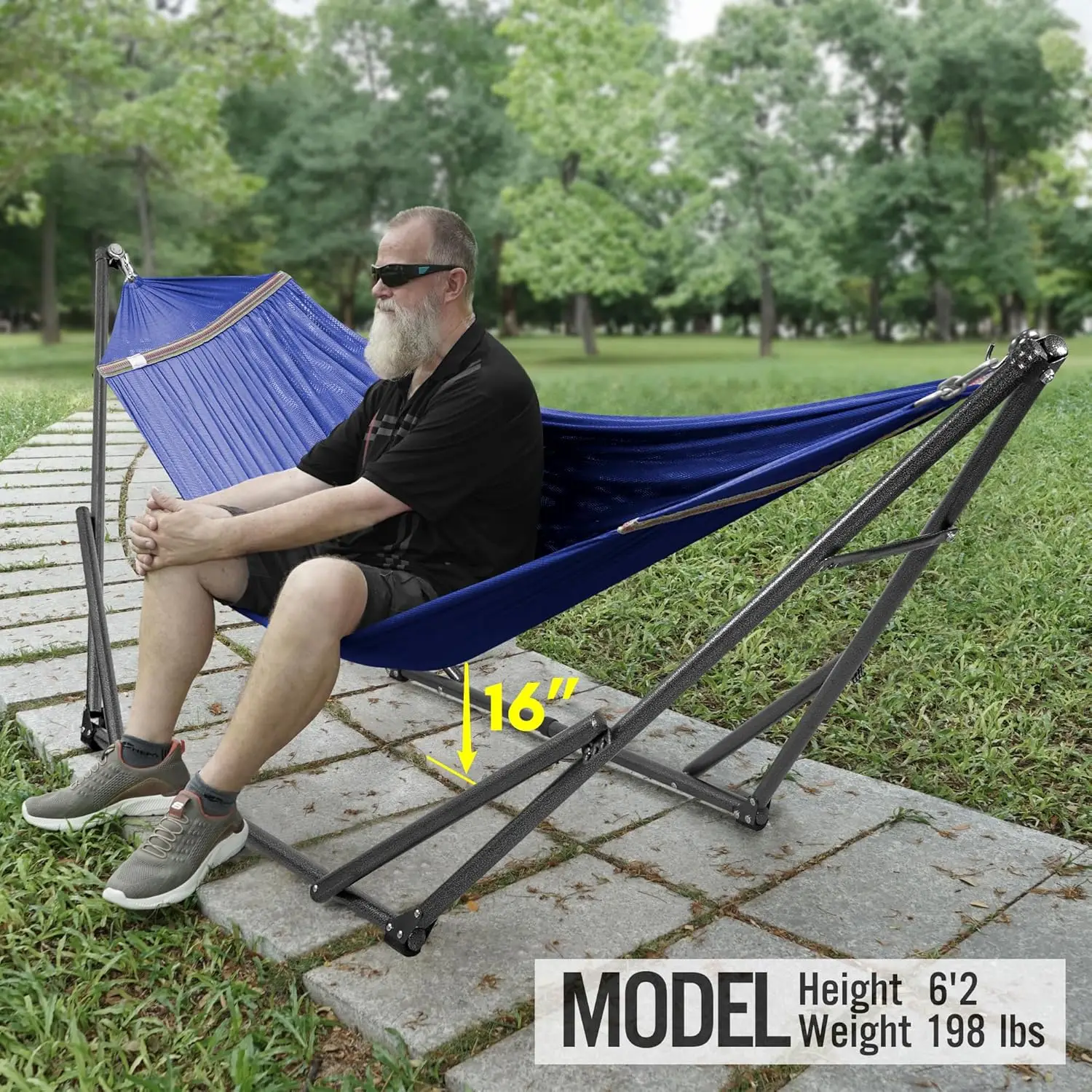
When comparing options for your ideal setup, understanding the most comfortable hammock types can help guide your decisions based on your specific comfort preferences and body type.
If your setup meets most of these criteria, congratulations—you’ve achieved near-perfect hammock depth! If not, return to the adjustment techniques covered earlier and make small, incremental changes until you reach hammock nirvana.
Advanced Depth Techniques for Hammock Enthusiasts
Once you’ve mastered the basics of proper hammock depth, these advanced techniques can further enhance your lounging experience:
Fine-Tuned Asymmetrical Hanging
Intentionally hang your foot end 1-2 inches (2.5-5 cm) lower than your head end to create a subtle incline that many find more comfortable for sleeping. This slight asymmetry works with gravity to prevent sliding and can reduce pressure on your sinuses.
Seasonal Depth Adjustments
• Summer: Increase depth slightly for more air circulation around your body
• Winter: Reduce depth marginally to minimize air space that needs warming
Activity-Specific Modifications
• Reading: Slightly less depth creates a more upright position at the head end
• Sleeping: Optimal 30-degree angle for flat diagonal positioning
• Social lounging: Slightly increased depth for a more reclined, relaxed position
Dynamic Suspension Systems
Consider incorporating shock cord segments or suspension systems that allow micro-adjustments to depth as temperature and humidity change the stretch characteristics of your hammock fabric.
The specialized hammock designs for enhanced comfort often incorporate these advanced principles directly into their construction, making them particularly suitable for enthusiasts looking to maximize their lounging experience.
These advanced techniques are the difference between a good hammock setup and a truly exceptional one that perfectly matches your unique body type and relaxation preferences.
Conclusion: The Art & Science of Perfect Hammock Depth
Finding your perfect hammock depth combines both scientific principles and personal preference. The 30-degree angle provides a reliable starting point, but your ultimate comfort depends on fine-tuning based on your body, your hammock type, and how you plan to use it.
Remember these key takeaways:
– Proper depth creates even weight distribution and eliminates pressure points
– The diagonal lay transforms a curved hammock into a flat, comfortable surface
– A structural ridgeline ensures consistent depth regardless of hanging conditions
– Different hammock styles require different approaches to depth
The journey to perfect hammock depth is a personal one. What works flawlessly for someone else might need adjustment for your body type and comfort preferences. Don’t be afraid to make small changes and test different configurations until you discover your ideal setup.
With these principles and techniques, you’re now equipped to transform any hammock into an oasis of comfort through the often-overlooked but crucial element of perfect depth.

